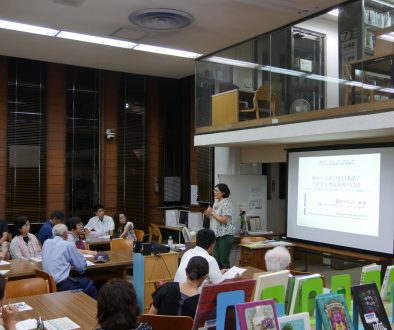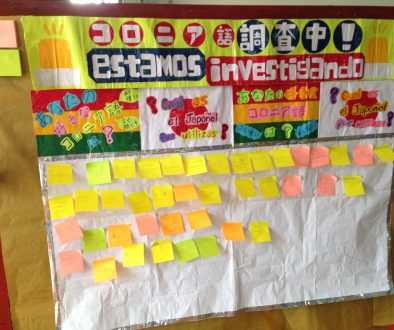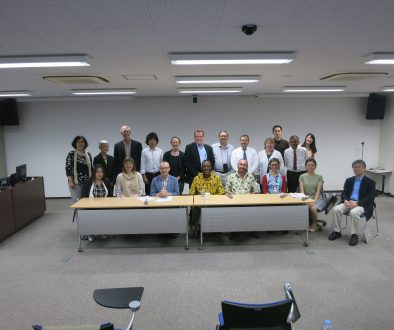How We Prepare For The Qingming Festival
This time I want to introduce you to “Qingming” from the point of view of an ordinary house.
(*There might be opinions and customs that aren’t considered “ordinary”….)
The Qingming (or Ching Ming) Festival has Chinese origins. In Okinawa it is a very important annual family event.
(Reference) Naha City Museum of History Digital Gallery “Kinjoh family’s Qingming Festival”
Qingming takes place in one of the 24 divisions of the solar year called “Qingming”. People try to adjust so it fits the schedule of everyone in the family.
A representative from each branch of the family and relatives (we call them “monchu”), gather a week before to clean out the tombs called “kamiu-qingming”. If necessary we also repair the graves. In the kamiu-qingming we are supposed to pray to all our ancestors and thank them beforehand. This is something that the representatives of the monchu do so I’ve never been part of it. From about a week before the kamiu-qingming the adults start rushing with preparations and the kids who don’t know about this enjoy Qingming in a relaxed mood.
From here, a report from our family’s 2016 Qingming Festival:
- Late April Saturday, buying ingredients for the jyubako (large stacked bento boxes used in special occasions).
Since both of my parents work and don’t have enough time, the pre-made dishes sold in supermarkets are very helpful.
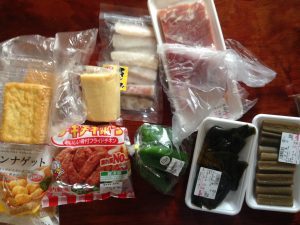
This is how our groceries looked like.
- The morning of the actual day; preparations
And the morning of the next day.
My mother cooking from early in the morning.
My father watching TV in the living room.
This is how the jyubako, traditional boxes of food made for special occasions, turned out.
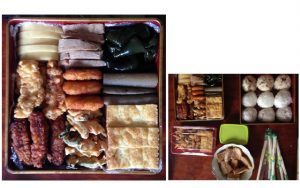
People might get bored since the dishes are mainly deep-fried foods and pot-cooked foods, chicken (popular to kids) is sometimes replaced by kamaboko or tempura. Since the jyubako is going to be late lunch, the mochi, rice cake, is replaced by rice balls.
Mother “the jyubako is ready”
Father “finally”
My brother wakes up and we are ready to go.
- To the monchu
The tombs are about 5 minute by car from out place.
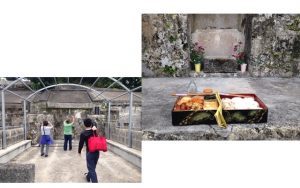
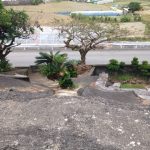
In this hill, there are many monchu tombs.
They are all tombs of people who have lived around here.
(The photos on the top right are photos of the tomb taken from above)
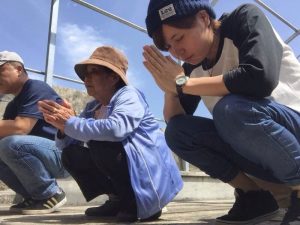
*I got permission to include this nicely taken photo of “utoto” (to join hands together in prayer to our ancestors).
“We are the fifth son’s family. We were able to have a safe year thanks to our great ancestors. We hope that this year….” The prayers consisted of something like this and it’s said in Uchinaaguchi, the local language.
- To monchu tombs in a different town
We went to a town not-so-far from here to see our even ‘greater’ ancestors. The “Qingming” usually consists of going to these two tombs and then going to the beach or a park to eat the jyubako.
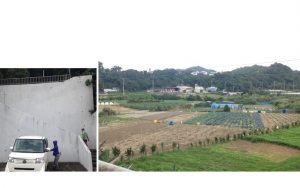
This is how the second location looks like.
The white wall, parking lot and benches were made when they repaired the places a few decades ago, it’s now an elderly-friendly place.
- Important steps for an offering
First, we offer an incense stick (flat type), and pour some sake on the entrance of the tomb. Then we open up the jyubako. There´s an important point when offering the jyubako. We are only supposed to place one of the dishes. I assume we do this so it is easier for the ancestors to eat, it’s just a small act of thoughtfulness towards them. We take off the saran wrap from the rice balls. Before going to the second location, the foods that were once taken out to offer, are replaced with the spare ones.
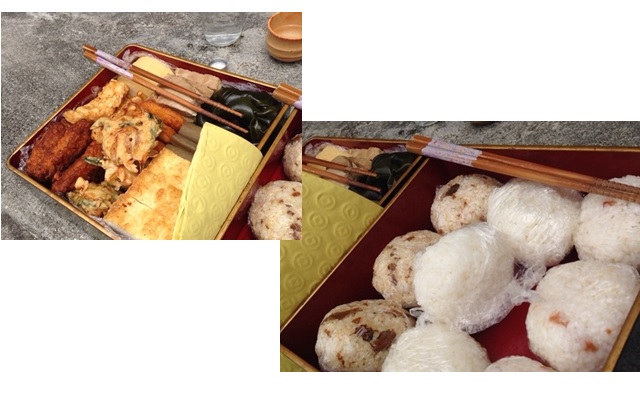
We burn (to do “uchikabi”) incense sticks and bills (“binshi” money from the world of the dead), and we thank our ancestors and ask them for good luck for the coming year and when the smoke settles, we put away the jyubako and the sake.
- Old graveyard ruins
From the opposite side of the same mountain, we can find the entrance to the ruins.


On the slope of the mountain, there is a hollow spot which is the tomb. Here we join our hands in prayer and leave some offerings. My father doesn’t know very well of this ruin.
Even on windy days, a blow torch is very useful. Although I was a bit hesitant about completely burning up the money…
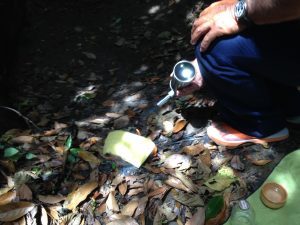
There were many mosquitos here so my mother and brother went back to the car. The smoke of the incense and the fire from the money burning took a while to settle so my father started smoking a cigarette. “I feel like there was one more stop we used to make years ago…” He mumbled.
This 30 minute car ride town is the place where all our ancestors lived long ago. Since there is no written records of their lives so going to visit their graves as a family event is a good way to learn about their history. Where are my descendants going to live? Are they going to be as excited as me visiting their ancestors’ graves? I thought to myself…
- Eating usande in the late afternoon
Finally, we head to the beach to eat lunch. Clearing up the offerings is called “usande-sabira”, we, including the youngest children eat what we have left from the offerings. There were other families having late lunches as well.

